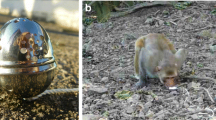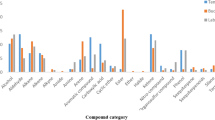Abstract
Three experiments were conducted to investigate whether wholebody and pouch odors facilitate social cohesion between young Virginia opossums and their mothers just prior to weaning. In experiment 1, young oriented toward plastic buckets containing their mothers, directing significantly higher levels of investigative behavior and more distress vocalizations toward them than toward buckets containing unrelated lactating females. In experiment 2, young oriented toward and investigated empty buckets containing whole-body odors of their mothers more than empty buckets containing odors of other females. Similarly, more investigative behavior was directed toward plastic bucket lids containing pouch odors from subjects' mothers than toward pouch odors from unrelated females in experiment 3. These results suggest that social odors help young didelphid marsupials maintain contact with their mothers, as in other mammals, and that whole-body and pouch gland odors are important chemical signals in this nongregarious species.
Similar content being viewed by others
References
Austad, S.N. 1992. Retarded senescence in an insular population of Virginia opossums (Didelphis virginiana).J. Zool. In press.
Bernstein, I.S. 1991. An empirical comparison of focal and ad libitum scoring with commentary on instantaneous scans, all occurrence and one-zero techniques.Anim. Behav. 42:721–728.
Boggs, J. 1969. The general and agonistic behavior of the mouse opossum,Marmosa robinsoni. MS thesis. San Diego State University, San Diego, California, 80 pp.
Brown, R.E., andMacdonald, D.W. (eds.) 1985. Social Odours in Mammals, Vol. I. Clarendon Press, Oxford, U.K.
Eisenberg, J.F. 1975. Phylogeny, behavior and ecology in the Mammalia, pp. 47–68,in W.P. Luckett and F.S. Szalay (eds.). Phylogeny of Primates. Plenum Press, New York.
Fadem, B.H. 1989. The effects of pheromonal stimuli on estrus and peripheral plasma estradiol in female gray short-tailed opossums (Monodelphis domestica).Biol. Reprod. 41:213–217.
Fadem, B.H., andCole, E.A. 1985. Scent-marking in the grey short-tailed opossum (Monodelphis domestica).Anim. Behav. 33:730–738.
Fadem, B.H., andSchwartz, R.A. 1986. A sexually dimorphic scent gland in gray short-tailed opossums (Monodelphis domestica).J. Mammal 67:205–208.
Fitch, M.W., andShirer, H.W. 1970. A radiotelemetric study of spatial relationships in the opossum.Am. Midl. Nat. 84:170–186.
Gardner, A.L. 1982. Virginia opossum, pp. 3–36,in J.A. Chapman and G.A. Feldhamer (eds.). Wild Mammals of North America. John Hopkins University Press, Baltimore, Maryland.
Gillette, L.N. 1980. Movement patterns of radio-tagged opossums in Wisconsin.Am. Midl. Nat. 104:1–12.
Hartman, C. 1923. Breeding habits, development and birth of the opossum.Smithson. Rep. 1921:347–364.
Holmes, D.J. 1987. Social complexity and potential for chemocommunication in captive Virginia opossums,Didelphis virginiana Kerr. PhD dissertation. Bowling Green State University, Bowling Green, Ohio, 195 pp.
Holmes, D.J. 1990. Social and other correlates of scent marking in captive Virginia opossums,Didelphis virginiana Kerr. pp. 451–458,in D.W. Macdonald, S. Natynczuk and D. MüllerSchwarze (eds.). Chemical Signals in Vertebrates 5. Oxford University Press, Oxford, United Kingdom.
Holmes, D.J. 1991. Social behavior in captive Virginia opossums,Didelphis virginiana.J. Mammal. 72:402–410.
Holmes, D.J. 1992. Sternal odors as cues for social discrimination by female Virginia opossums,Didelphis virginiana.J. Mammal. 73:286–291.
Holmes Meisner, D. 1986. Histology and gross morphology of the sexually dimorphic sternal gland in the North American opossum,Didelphis virginiana Kerr. pp. 579–585,in D. Duvall, D. Müller-Schwarze, and R.M. Silverstein (eds.). Chemical Signals in Vertebrates 4: Ecology, Evolution, and Comparative Biology. Plenum, New York.
McManus, J.J. 1970. Behavior of captive opossums,Didelphis marsupialis virginiana.Am. Midl. Nat. 84:144–169.
McManus, J.J. 1971. Activity of captiveDidelphis marsupialis.J. Mammal 52:846–848.
Reynolds, H.C. 1952. Studies on reproduction in the opossum (Didelphis virginiana).Univ. Calif. Publ. Tool. 52:223–275.
Rhine, R.J., andFlanigan, M. 1978. An empirical comparison of one-zero, focal-animal and instantaneous methods of sampling spontaneous primate social behavior.Primates 19:352–361.
Russell, E.M. 1984. Social behaviour and social organization of marsupials.Mammal Rev. 14:101–154.
Russell, E.M. 1985. The metatherians: Order Marsupialia. pp. 45–104,in R.E. Brown and D.W. Macdonald (eds.). Social Odours in Mammals. Clarendon Press, Oxford, U.K.
Ryser, J. 1990. The mating system, ecology, and biology of the Virginia opossum,Didelphis virginiana, in north-central Florida. PhD dissertation. Universität Bern, Switzerland, 133 pp.
Seidensticker, J., O'Connell, andJohnsingh, A.J.T. 1987. Virginia opossum, pp. 247–261,in M. Novak, J.A. Baker, M.E. Obbard, and B. Malloch (eds.). Wild Furbearer Management and Conservation in North America. Ministry of Natural Resources, Ontario.
Sharman, G.B., andCalaby, J.H. 1964. Reproductive behavior in the red kangaroo,Megaleia rufa, in captivity.CSIRO Wildl. Res. 9:58.
Stoddart, D.M. 1980. The Ecology of Vertebrate Olfaction. Chapman and Hall, London.
Sunquist, M.E., Austad, S.N., andSunquist, F. 1987. Movement patterns and home range in the common opossum (Didelphis marsupialis).J. Mammal. 68:3–6.
Wright, D.D. 1989. Mortality and dispersal of juvenile opossums,Didelphis virginiana. MS thesis. University of Florida, Gainesville, 100 pp.
Zar, J.H. 1984. Biostatistical Analysis. Prentice-Hall, Englewood Cliffs, New Jersey, 718 pp.
Author information
Authors and Affiliations
Rights and permissions
About this article
Cite this article
Holmes, D.J. Odors as cues for orientation to mothers by weanling Virginia opossums. J Chem Ecol 18, 2251–2259 (1992). https://doi.org/10.1007/BF00984948
Received:
Accepted:
Issue Date:
DOI: https://doi.org/10.1007/BF00984948




